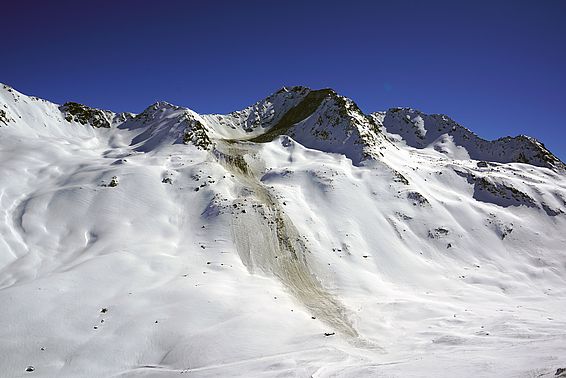02.11.2022 | Christine Huovinen | News SLF
RAMMS (Rapid Mass Movement Simulation) is a long-standing simulation tool for avalanches, rockfall and debris flows. The SLF's RAMMS research group is now working on further modules for this software package.
The SLF showcases the research groups of the Climate Change, Extremes and Natural Hazards in Alpine Regions Research Centre CERC, in no particular order. Founded in 2021, the CERC is sponsored by the Canton of Grisons and the Swiss Federal Institute for Forest, Snow and Landscape Research WSL and is supported by ETH Zurich. It is part of the SLF in Davos.
Expert practitioners had long been calling for a user-friendly computerised tool to simulate avalanches or other natural hazards as realistically as possible, with a view to creating hazard maps or planning protective measures. The SLF first met this demand with the launch of the Rapid Mass Movement Simulation software package RAMMS::Avalanche in 2010. Since then, the package has been further developed and now enables the calculation and visualisation, for a range of initial scenarios, of rockfall and debris flows as well as avalanches. Users can select, for example, volume of snow or rock shape for any slope and identify on screen the paths that snow or rocks follow on the terrain.
Used internationally
RAMMS is now being used successfully in many countries around the world. The SLF's RAMMS research group, which is part of the Climate Change, Extremes and Natural Hazards in Alpine Regions Research Centre (CERC), was recently commissioned by the Swiss Agency for Development and Cooperation (SDC) and UNESCO to train local experts in Georgia and Kazakhstan in using the software. RAMMS group leader Perry Bartelt says: "This kind of exchange with practitioners in the field nationally and internationally is one of my research group's key tasks."
Various RAMMS simulations: Top row: Dust avalanche simulation of the avalanche track in Val Barcli, Zernez; RAMMS simulation of the rockfall and snow avalanche at Flüela Wisshorn. Bottom row: Rockfall simulation with RAMMS::Rockfall; rock/ice avalanche simulation of Chamoli, India.
More modules in progress
The group is currently working on further modules for RAMMS, including one that calculates the process involved in rock/ice avalanches. However, information from natural events is still needed to verify the computer simulation. For example, the RAMMS group simulated the March 2019 event at Flüela Wisshorn in the Swiss canton of Grisons and compared the result with the real-world data, thereby providing an important piece of the puzzle in the ongoing fine-tuning of the module.
In his recently completed thesis, geographer Adrian Ringenbach also provided measurement results for a new rockfall module: in a protection forest in Surava, he rolled rocks fitted with sensors down a slope – once with and once without lying deadwood. The data help to extend the rockfall simulation to include the barrier effect of deadwood.
The avalanche and debris flow modules are also being continuously improved. Bartelt says: "In the case of avalanches, we are working on developing a module for powder avalanches. For debris flows, we are expanding the software into a two-phase module, meaning that it can be used to calculate both the liquid and the solid phases of the mixture of water and rock material. We also have many other ideas about how we can further develop RAMMS as a practical tool."
Contact
Copyright
WSL and SLF provide the artwork for imaging of press articles relating to this media release for free. Transferring and saving the images in image databases and saving of images by third parties is not allowed.
